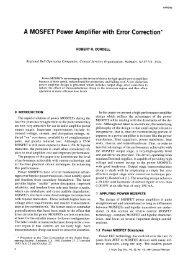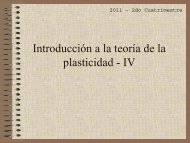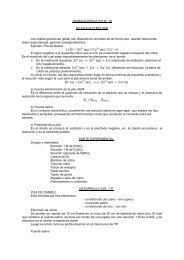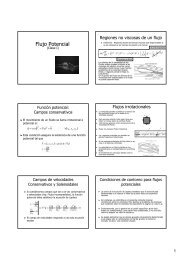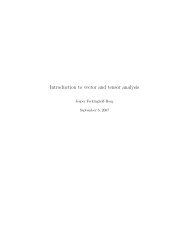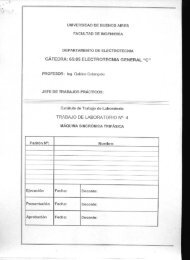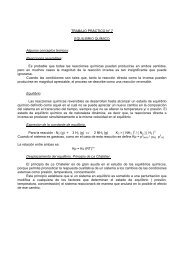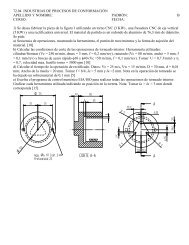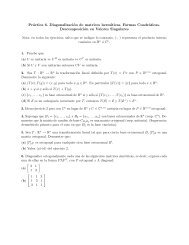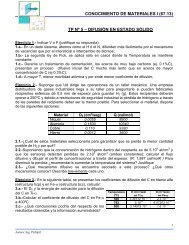Download PDF
Download PDF
Download PDF
You also want an ePaper? Increase the reach of your titles
YUMPU automatically turns print PDFs into web optimized ePapers that Google loves.
Ahlbom<br />
EMF through residential, including heated<br />
bed, exposure or through the workplace is<br />
associated with adverse pregnancy outcomes.<br />
Discussion<br />
Epidemiologic investigation of possible associations<br />
of EMF exposure with risk of chronic<br />
disease is an unusually difficult enterprise.<br />
Certain conclusions can be drawn however:<br />
a) The epidemiologic studies conducted<br />
on possible health effects of EMF have<br />
improved over time in sophistication of exposure<br />
assessment and in methodology. Several<br />
of the recent studies on childhood leukemia<br />
and on occupational exposures in relation to<br />
adult cancer are close to the limit of what can<br />
realistically be achieved by epidemiology, in<br />
terms of size of study and methodological<br />
rigor, using presently available measurement<br />
methods.<br />
b) Exposure measurement is a particular<br />
difficulty of EMF epidemiology, in several<br />
respects:<br />
• The exposure of interest is imperceptible,<br />
ubiquitous, originates from multiple<br />
sources, and can vary greatly over time<br />
and over relatively short distances.<br />
• The relevant exposure period, for cancers<br />
at least, is before the date at which measurements<br />
can realistically be obtained<br />
and is of unknown duration and induction<br />
period.<br />
• The appropriate exposure metric is<br />
unknown, and there is no substantiated<br />
biological mechanism or animal model<br />
from which to impute it.<br />
c) In the absence of evidence from cellular<br />
or animal studies, and given the methodological<br />
uncertainties and in many cases inconsistencies<br />
of the existing epidemiologic<br />
literature, there is no chronic disease outcome<br />
for which an etiological relation to EMF<br />
exposure can be regarded as established.<br />
d ) A large body of high-quality data<br />
exists, with measurements of exposure,<br />
strong methodology, and large study sizes,<br />
for childhood leukemia and brain tumors<br />
and for occupational exposure in relation to<br />
adult leukemia and brain tumors. Among all<br />
the outcomes evaluated in epidemiologic<br />
studies of EMF, childhood leukemia in relation<br />
to postnatal exposures above 0.4 µT is<br />
the one for which there is most evidence of<br />
an association. The relative risk has been estimated<br />
at 2.0 (95% confidence limits (CL) =<br />
1.27–3.13) in a large pooled analysis. This is<br />
unlikely to be due to chance but may be<br />
partly due to bias. This is difficult to interpret<br />
in the absence of a known mechanism<br />
or reproducible experimental support. In the<br />
large pooled analysis, only 0.8% of all children<br />
were exposed above 0.4 µT. Further<br />
studies need to be designed to test specific<br />
hypotheses such as aspects of selection bias or<br />
exposure. On the basis of epidemiologic<br />
findings, there is evidence for an association<br />
of ALS with occupational EMF exposure<br />
although confounding is a potential explanation.<br />
Whether there are associations with<br />
breast cancer, cardiovascular disease, and<br />
suicide and depression remains unresolved.<br />
Overall, despite 20 years of extensive epidemiologic<br />
investigation of the relation of<br />
EMF to risk of chronic disease, there are still<br />
epidemiologic questions that need to be<br />
resolved. To be of value, however, future<br />
studies of these questions must be of high<br />
methodological quality, of sufficient size and<br />
with sufficient numbers of highly exposed<br />
subjects, and must include appropriate exposure<br />
groups and sophisticated exposure assessment.<br />
Especially for childhood leukemia,<br />
little is to be gained from further repetition of<br />
investigation of risks at moderate and low<br />
exposure levels, unless such studies can be<br />
designed to test specific hypotheses, such as<br />
selection bias or aspects of exposure not previously<br />
captured. In addition there is a need for<br />
studies in humans of possible physiological<br />
effects of EMF that might relate to risks of<br />
chronic disease.<br />
REFERENCES AND NOTES<br />
1. Jackson JD. Are the stray 60-Hz electromagnetic fields associated<br />
with distribution and use of electric power a significant<br />
cause of cancer? Proc Natl Acad Sci U S A 89:3508–3510<br />
(1992).<br />
2. Swanson J. Long-term variations in the exposure of the population<br />
of England and Wales to power-frequency magnetic fields.<br />
J Radiol Prot 16:287–301 (1996).<br />
3. Wertheimer N, Leeper E. Electrical wiring configurations and<br />
childhood cancer. Am J Epidemiol 109:273–284 (1979).<br />
4. Repacholi M, Ahlbom A. Commentary. Lancet 354:1918–1919<br />
(1999).<br />
5. Kaune WT, Davis S, Stevens RG, Mirick DK, Kheifets L.<br />
Measuring temporal variability of residential magnetic field<br />
exposures. Bioelectromagnetics 22(4):232–245 (2001).<br />
6. Milham S. Mortality from leukemia in workers exposed to electrical<br />
and magnetic fields [Letter to the Editor]. N Engl J Med<br />
307:249 (1982).<br />
7. Forssén UM, Feychting M, Rutqvist LE, Floderus B, Ahlbom A.<br />
Occupational and residential magnetic field exposure and<br />
breast cancer in females. Epidemiology 11:24–29 (2000).<br />
8. Green LM, Miller AB, Agnew DA, Greenberg ML, Li J,<br />
Villeneuve PJ, Tibshirani R. Childhood leukemia and personal<br />
monitoring of residential exposures to electric and magnetic<br />
fields in Ontario, Canada. Cancer Causes Control 10:233–243<br />
(1999).<br />
9. McBride ML, Gallagher RP, Theriault G, Armstrong BG, Tamaro<br />
S, Spinelli JJ, Deadman JE, Fincham S, Robson D, Choi W.<br />
Power-frequency electric and magnetic fields and risk of childhood<br />
leukemia in Canada. Am J Epidemiol 149:831–842 (1999).<br />
10. Kleinerman RA, Linet MS, Hatch EE, Wacholder S, Tarone RE,<br />
Severson RK, Kaune WT, Friedman DR, Haines CM, Muirhead<br />
CR, et al. Magnetic field exposure assessment in a case-control<br />
study of childhood leukemia. Epidemiology 8:575–583 (1997).<br />
11. Wertheimer N, Leeper E. Adult cancer related to electrical<br />
wires near home. Am J Epidemiol 11:345–355 (1982); 273–284<br />
(1979).<br />
12. Savitz DA, Wachtel H, Barnes FA, John EM, Tvrdik JG. Casecontrol<br />
study of childhood cancer and exposure to 60-hertz<br />
magnetic fields. Am J Epidemiol 128:21–38 (1988).<br />
13. Kaune WT, Stevens RG, Callahan NJ, Severson RK, Thomas DE.<br />
Residential magnetic and electric fields. Bioelectromagnetics<br />
8:315–335 (1987).<br />
14. Barnes F, Wachtel H, Savitz D, Fuller J. Use of wiring configuration<br />
and wiring codes for estimating externally generated electric<br />
and magnetic fields. Bioelectromagnetics 10:13–21 (1989).<br />
15. London SJ, Thomas DC, Bowman JD, Sobel E, Cheng T-C,<br />
Peters JM. Exposure to residential electric and magnetic fields<br />
and risk of childhood leukemia. Am J Epidemiol 134:923–937<br />
(1991).<br />
16. Tarone RE, Kaune WT, Linet MS, Hatch EE, Kleinerman RA,<br />
Robison LL, Boice JD Jr, Wacholder, S. Residential wire codes:<br />
reproducibility and relation with measured magnetic fields.<br />
Occup Environ Med 55:333–339 (1998).<br />
17. Kheifets LI, Kavet R, Sussman SS. Wire codes, magnetic fields,<br />
and childhood cancer. Bioelectromagnetics 18:99–110 (1997).<br />
18. Kaune WT, Zaffanella LE. Assessing historical exposures of<br />
children to power-frequency magnetic fields. J Expo Anal<br />
Environ Epidemiol 4(2):149–170 (1994).<br />
19. Preston-Martin S, Navidi W, Thomas D, Lee P-J, Bowman J,<br />
Pogoda J. Los Angeles study of residential magnetic fields and<br />
childhood brain tumors. Am J Epidemiol 143:105–119 (1996).<br />
20. Kaune WT, Savitz DA. Simplification of the Wertheimer-Leeper<br />
wire code. Bioelectromagnetics 15:275–282 (1994).<br />
21. Linet MS, Hatch EE, Kleinerman RA, Robison LL, Kaune WT,<br />
Friedman DR, Severson RK, Haines CM, Hartsock CT, Niwa S, et<br />
al. Residential exposure to magnetic fields and acute lymphoblastic<br />
leukemia in children. N Engl J Med 337:1–7 (1997).<br />
22. Savitz DA, Kaune WT. Childhood cancer in relation to a modified<br />
residential wire code. Environ Health Perspect 101:76–80<br />
(1993).<br />
23. Tomenius L. 50-Hz electromagnetic environment and the incidence<br />
of childhood tumors in Stockholm County.<br />
Bioelectromagnetics 7:191–207 (1986).<br />
24. Coleman MP, Bell CMJ, Taylor HL, Primic-Zakelj M. Leukemia<br />
and residence near electricity transmission equipment: a casecontrol<br />
study. Br J Cancer 60:793–798 (1989).<br />
25. Myers A, Clayden AD, Cartwright RA, Cartwright SC. Childhood<br />
cancer and overhead power lines. A case-control study. Br J<br />
Cancer 62:1008–1011 (1990).<br />
26. Tynes T, Haldorsen T. Electromagnetic fields and cancer in children<br />
residing near Norwegian high-voltage power lines. Am J<br />
Epidemiol 145:219–226 (1997).<br />
27. Verkasalo PK, Pukkala E, Hongstro MY, Valjus JE, Jarvinen PJ,<br />
Heikkila KV, Koskenvuo M. Risk of cancer in Finnish children living<br />
close to power lines. Br Med J 307:895–899 (1993).<br />
28. Olsen JH, Nielsen A, Schulgen G. Residence near high voltage<br />
facilities and risk of cancer in children. Br Med J 307:891–895<br />
(1993).<br />
29. Kleinerman RA, Kaune WT, Hatch EE, Wacholder S, Linet MS,<br />
Robison LL, Niwa S, Tarone RE. Are children living near highvoltage<br />
power lines at increased risk of acute lymphoblastic<br />
leukemia? Am J Epidemiol 151:512–515 (2000).<br />
30. Ericson A, Kallen B. An epidemiological study of work with<br />
video screens and pregnancy outcome. II: A case-control study.<br />
Am J Ind Med 9:459–475 (1986).<br />
31. Lynge E, Kurppa K, Kristofersen L, Malker H, Sauli H. Silica<br />
dust and lung cancer: results from the Nordic occupational<br />
mortality and cancer incidence registers. J Natl Cancer Inst<br />
77:883–889 (1986).<br />
32. Feychting M, Ahlbom A. Magnetic fields and cancer in children<br />
residing near Swedish high-voltage power lines. Am J<br />
Epidemiol 138:467–481 (1993).<br />
33. Michaelis J, Schuz J, Meinert R, Menger M, Grigat J-P,<br />
Kaatsch P, Kaletsch U, Miesner A, Stamm A, Brinkmann K, et<br />
al. Childhood leukemia and electromagnetic fields: results of a<br />
population-based case-control study in Germany. Cancer<br />
Causes Control 8:167–174 (1997).<br />
34. Michaelis J, Schuz J, Meinert R, Zemann E, Grigat J-P, Kaatsch<br />
P, Kaletsch U, Miesner A, Brinkmann K, Kalkner W, et al.<br />
Combined risk estimates for two German population-based<br />
case-control studies on residential magnetic fields and childhood<br />
acute leukemia. Epidemiology 9:92–94 (1997b).<br />
35. Dockerty JD, Elwood JM, Skegg DCG, Herbison GP.<br />
Electromagnetic field exposures and childhood cancers in New<br />
Zealand. Cancer Causes Control 9:299–309 (1998).<br />
36. Green LM, Miller AB, Villeneuve PJ, Agnew DA, Greenberg ML,<br />
Li J, Donnelly KE. A case-control study of childhood leukemia in<br />
southern Ontario, Canada, and exposure to magnetic fields in<br />
residences. Int J Cancer 82:161–170 (1999b).<br />
37. United Kingdom Childhood Cancer Study Investigators.<br />
Exposure to power-frequency magnetic fields and the risk of<br />
childhood cancer. Lancet 354:1925–1931 (1999).<br />
38. Jaffe KC, Kim H, Aldrich TE. The relative merits of contemporary<br />
measurements and historical calculated fields in the Swedish<br />
childhood cancer study. Epidemiology 11:353–356 (2000).<br />
39. Kaune WT, Darby SD, Gardner SN, Hrubec Z, Iriye RN, Linet<br />
MS. Development of a protocol for assessing time-weightedaverage<br />
exposures of young children to power-frequency magnetic<br />
fields. Bioelectromagnetics 15:33–51 (1994).<br />
930 VOLUME 109 | SUPPLEMENT 6 | December 2001 • Environmental Health Perspectives



